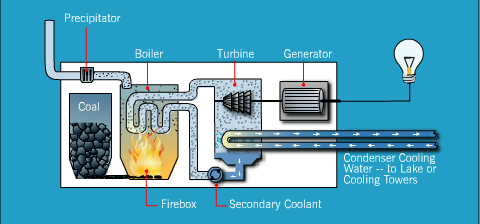Today’s blog post will be focusing on the generation of electricity. While there are many different ways that electricity can be generated, the three I will explore today are electricity Generation from coal-fired, natural gas, and nuclear power plants. Through each individual process of generation, one can see the benefits and downfalls of each type of power plant.
1. Coal-fired power plants.
In coal-fired power plants,water is turned into steam, which then causes turbine generators to produce electricity. There are few steps to this process. First, heat must be created by reducing it to the fineness of talcum powder. After mixing it with hot water and air, it is put into the firebox which provides the maximum heat. Next, water is pumped through the pipes into the boiler, which in conjunction with the heat, creates steam that gets up to 1,000 fahrenheit. Then the steam creates a pressure that goes against a series of giant turbine blades which turn the turbine shaft, which is connected to the shaft of the generator , where electricity is produced. Finally, the steam enters a condenser where millions of gallons of cool water from a nearby source are pumped through a network of tubes running through the condenser. The cool water then turns the steam back into water so it can be used again to repeat the cycle.
Here is an image of the coal-fired power plant in its entirety:
Although low cost and versatile, coal-fired plants create high levels of pollution which causes health threats to society, and obvious destruction in nature. Furthermore, coal is not a renewable energy source. As you can see, there are many benefits and downfalls of coal-fired power plants.
http://www.duke-energy.com/about-energy/generating-electricity/coal-fired-how.asp
2. Natural Gas power plants
There are three types of natural gas power plants. They are steam generation, simple cycle, and combined cycle. Similar to a coal-fired power plant, the steam generation plant uses natural gases to create steam that causes the turbines to spin and create electricity. The simple cycle plant burns natural gas to produce a high pressure gas that spins the turbine and convert electricity. These plants are used in times of high demand because of their short start-up times, however they are not very efficient in converting heat into electricity. Combined cycle plant use a heat recovery steam generator and simple cycle turbines to power itself. In this plant, gas is burned to create high pressure gas and the excess heat from that process is captured and used to generate steam to spin a steam turbine. This plant is the most efficient of the natural gas plants, but due to its longer start up time, it is not used for the majority of the time.
Here is a picture of the three different kinds:
According to AEP.com, “The International Energy Administration (IEA) indicates that combined cycle gas plants have a higher average efficiency than coal plants. Simple cycle plants have efficiencies ranging from 35 – 42% and combined cycle plants have efficiencies of 52 – 60% compared to efficiencies of up to 46% for supercritical coal plants and 50% for ultra supercritical coal plants.”
Clearly, the natural gas plant is a better option than coal.
http://www.aep.com/about/IssuesAndPositions/Generation/Technologies/NaturalGas.aspx
3. Nuclear power plants
The nuclear power plant is a thermal power station heated by a nuclear reactor. The heat produced by the reactor produces steam to spin the steam turbine which is connected to a generator the produces electricity. The nuclear power plants produce around 20% of our nations power! Although this system sounds simple, they are the most complex and sophisticated energy generators. According to ,Jan Willem Storm van Leeuwen “A fundamental issue contributing to a nuclear power system’s complexity is its extremely long lifetime. The timeframe from the start of construction of a commercial nuclear power station through the safe disposal of its last radioactive waste, may be 100 to 150 years.” Furthermore, nuclear power plants also pose a threat to the health and safety of the public living near the plant. “The major hazards to people in the vicinity of the plume are radiation exposure to the body from the cloud and particles deposited on the ground, inhalation of radioactive materials and ingestion of radioactive materials.” A high exposure to radiation could cause death or serious illness. For this reason, the government has an emergency response plan in the event of a nuclear power plant incident.
Here is a picture of the Nuclear power plant:
http://www.ready.gov/nuclear-power-plants



I enjoyed reading your blog because it showed a very detailed analysis of each process of generating electricity, and you did not skim on the facts. By including useful images too, you evolved your words into something greater, and allowed for the reader to gain a better understanding of what you were trying to put across in your blog. Lastly, with the inclusion of the process, you outlined the danger of nuclear power which helped me better understand it’s uniqueness.
Thanks for sharing
Great topic ! BIG Like !
I enjoyed looking at the diagrams you produced they were very detailed as was the blog.
Coal seems the safest route, but I may be wrong.
This is very good post with detailed information on “How electricity generated.” All these coal based electric generator, natural gas based electric generator and nuclear power generators produces a lot of power and also big sources of pollution also.
Very detailed diagrams, and interesting read. Thanks for the blog.
I always interesting if I read how things work. thanks, nice post
Very good post. I just found your weblog and want to say that I really like surfing your blog posts. However I will subscribe to your rss feed and I hope you write one more time soon! Jual Pipa Tube Boiler